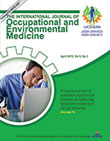فهرست مطالب

International Journal of Occupational and Environmental Medicine
Volume:6 Issue: 2, Apr 2015
- تاریخ انتشار: 1394/06/10
- تعداد عناوین: 7
-
-
Pages 61-78BackgroundPhysical and psychological job demands in combination with the degree of control a worker has over task completion, play an important role in reducing stress. Occupational stress is an important, modifiable factor affecting work disability. However, the effectiveness of reducing job demands or increasing job control remains unclear, particularly for outcomes of interest to employers, such as absenteeism or productivity.ObjectiveThis systematic review reports on job demand and control interventions that impact absenteeism, productivity and financial outcomes.MethodsA stakeholder-centered best-evidence synthesis was conducted with researcher and stakeholder collaboration throughout. Databases and grey literature were searched for systematic reviews between 2000 and 2012: Medline, EMBASE, the Cochrane Database of Systematic Reviews, DARE, CINAHL, PsycINFO, TRIP, health-evidence.ca, Rehab, National Rehabilitation Information Center (NARIC), and Institute for Work and Health. Articles were assessed independently by two researchers for inclusion criteria and methodological quality. Differences were resolved through consensus.ResultsThe search resulted in 3363 unique titles. After review of abstracts, 115 articles were retained for full-text review. 11 articles finally met the inclusion criteria and are summarized in this synthesis. The best level of evidence we found indicates that multimodal job demand reductions for either at-work or off-work workers will reduce disability-related absenteeism.ConclusionIn general, the impacts of interventions that aim to reduce job demands or increase job control can be positive for the organization in terms of reducing absenteeism, increasing productivity and cost-effectiveness. However, more high quality research is needed to further assess the relationships and quantify effect sizes for the interventions and outcomes reviewed in this study.Keywords: Job demands, Job control, Workplace, Efficiency, organizational
-
Pages 79-94BackgroundWorkplace stress is known to be related with many behavioral and disease outcomes. However, little is known about its prospective relationship with measures of cognitive decline.ObjectiveTo investigate the association of job strain, psychological demands and job control on cognitive decline.MethodsParticipants from Framingham Offspring cohort (n=1429), were assessed on job strain, and received neuropsychological assessment approximately 15 years and 21 years afterwards.ResultsHigh job strain and low control were associated with decline in verbal learning and memory. Job strain was associated with decline in word recognition skills. Active job and passive job predicted decline in verbal learning and memory relative to low strain jobs in the younger subgroup. Active job and demands were positively associated with abstract reasoning skills.ConclusionsJob strain and job control may influence decline in cognitive performance.Keywords: Job strain, Cognition disorders, Work, Job demand, Active work, Passive work, Stress, psychological
-
Pages 95-103BackgroundVery few studies have been performed on small populations about the links between employment and bariatric surgery.ObjectiveTo determine if rates of employment are increased among patients who have undergone bariatric surgery, to assess their post-operative health consequences (post-prandial weakness, diarrhea), and patient's ability to maintain post-operative advice (ie, 30 minutes of daily physical activity, 6 small meals daily) compared to non-employed post-surgical patients.MethodsThis cross-sectional study was performed in the Regional Reference Centre for Obesity, which is a partnership between the University Hospital and a clinic in Angers, France during 2012 using a self-administrated questionnaire completed by patients hospitalized for post-operative follow-ups after bariatric surgery. Issues investigated were their professional situation before and after the surgery, compliancy to post-operative advice, and any postoperative side effects.ResultsEmployment rates were 64.4% before and 64.7% after the surgery (p=0.94). Of these, 30.6% maintained 30 minutes of daily physical activity vs. 41.0% of non-workers (p=0.02). 50.5% of employed patients and 57.3% of non-workers maintained 6 small meals a day after surgery (p=0.09). 8% of working patients reported post-prandial weaknesses and 8% reported diarrhea that caused problems at work.ConclusionEmployment rate remained stable after surgery. Having a job seemed to be an obstacle to managing 30 minutes of daily exercise, especially among women, but not maintaining 6 small meals a day. Therefore, working environment needs to be assessed to improve job quality and retention for patients who have undergone bariatric surgery.Keywords: Bariatric surgery, Employment, Obesity, morbid, Occupational health, Motor activity, Postoperative period
-
Pages 104-112BackgroundThe high prevalence of obesity among commercial truck drivers may be related to sedentary nature of the job, lack of healthy eating choices, and lack of exercise. There may be a link between obesity and crash risk, therefore an intervention to reduce obesity in this population is needed.ObjectiveTo assess feasibility of a 12-week weight loss intervention for truck drivers with a weight loss goal of 10% of initial body weight.MethodsDrivers were selected based on age (≥21 years) and body mass index (≥30 kg/m2). The drivers participated in a before-after clinical trial. The intervention included a 12-week program that provided information on healthy diet and increasing exercise, and telephone-based coaching using SMART goals. Outcomes included change from baseline in reported energy intake, measured weight, waist, hip, and neck circumference, blood pressure, and point of care capillary blood lipids and hemoglobin A1c. Exit interviews were conducted to gain insight into driver opinions on the program features and usefulness. This study was registered with the NIH Clinical Trials Registry, number NCT02348983.Results12 of 13 drivers completed the study. Weight loss was statistically significant (p=0.03). Reported energy (p=0.005), total fat consumption (p=0.04), and saturated fat consumption (p=0.02) intake were also lower after the 12-week intervention. Drivers attributed their weight loss to health coaching and suggested a longer intervention so that they could reach their goal and become accustomed to the changes.ConclusionThis weight loss intervention is feasible for this difficult population. Additional research is needed to compare this intervention with a control group.Keywords: Motor vehicles, Obesity, Health education, Occupational health, Workplace, Nutrition therapy
-
Pages 113-121BackgroundControversy exists as to the potential of asphalt fumes to induce respiratory symptoms and lung functional impairments.ObjectiveTo examine the respiratory effects, if any, of occupational inhalation exposure to asphalt fumes.MethodsIn this cross-sectional study, 74 asphalt workers and 110 unexposed employees were investigated. The prevalence of respiratory symptoms among subjects was investigated by a standard questionnaire. Additionally, the parameters of pulmonary function were measured both, prior to exposure and at the end of work-shift. Furthermore, to assess the extent to which workers were exposed to asphalt fumes, total particulate and the benzene-soluble fraction were measured in different worksites.ResultsThe mean levels of exposure to total particulate and benzene-soluble fraction in asphalt fumes were estimated to be 0.9 (SD 0.2) and 0.3 (SD 0.1) mg/m3, respectively. Mean values of FEV1, both prior to the exposure (89.58% [SD 18.69%] predicted value) and at the end of shift (85.38% [SD 19.4%]), were significantly (pConclusionSignificant decrements in the parameters of pulmonary function as well as, a significant increase in the prevalence of respiratory symptoms in asphalt paving workers compared to their unexposed counterparts provided evidence in favor of a significant association between exposure to asphalt fumes and lung function impairments.Keywords: Asphalt, Respiratory function tests, Signs, symptoms, respiratory, Occupational exposure, Mastic asphalt, Questionnaires, Benzene, Worksites, Threshold limit values, Air borne disease


